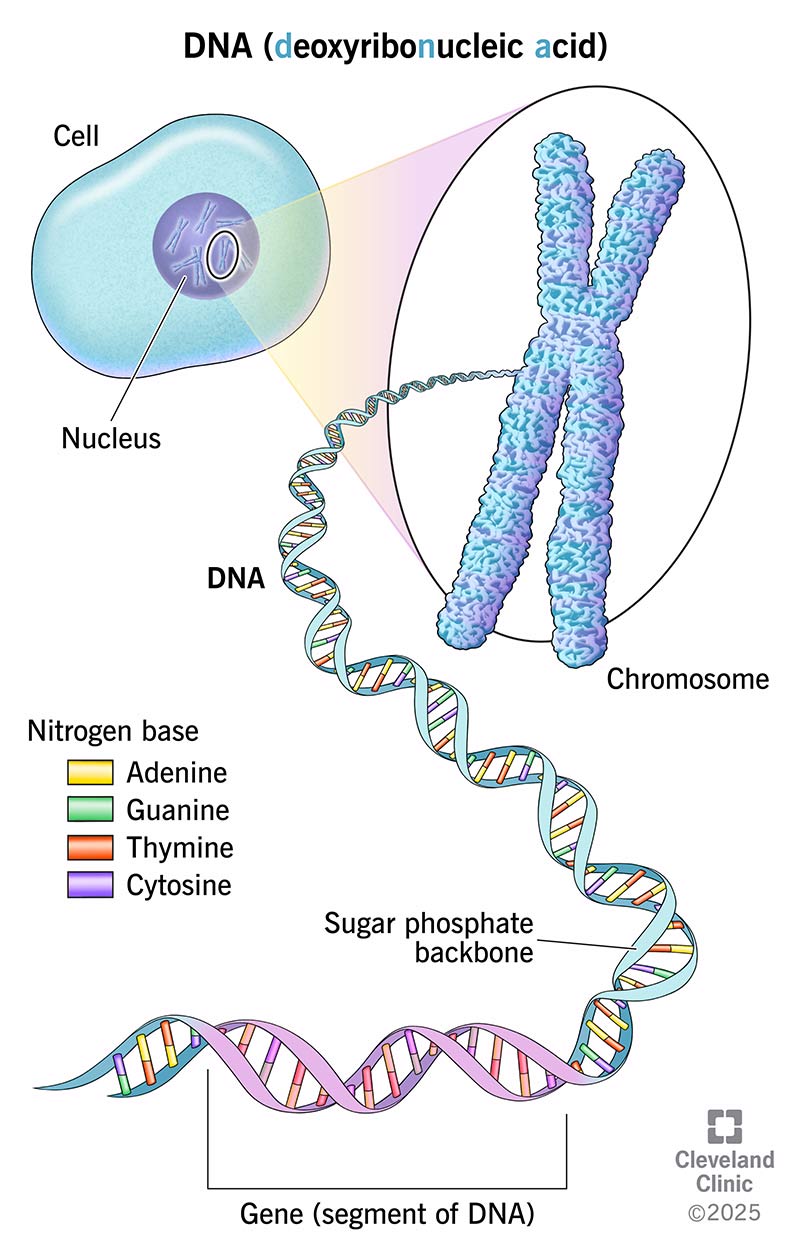DNA (deoxyribonucleic acid) is a set of instructions for creating the proteins that make your body work. Two strands of DNA together form a double helix — a bit like a spiral staircase. Sugars and phosphates make up the sides and base pairs make up the middle. Base pairs are the compounds adenine (A), cytosine (C), guanine (G) and thymine (T).
Advertisement
Cleveland Clinic is a non-profit academic medical center. Advertising on our site helps support our mission. We do not endorse non-Cleveland Clinic products or services. Policy

DNA is the set of instructions that make you, you. These instructions tell your body how to create organs and tissues, how to function and what you look like. You can think of DNA as a vast library of instruction manuals. It uses its own “language” to write the story of you that your cells can read.
Advertisement
Cleveland Clinic is a non-profit academic medical center. Advertising on our site helps support our mission. We do not endorse non-Cleveland Clinic products or services. Policy
All living things have DNA in their cells (and some viruses carry it with them, too). You inherit your DNA from your biological parents — you get half from your mother and half from your father.
The letters in DNA stand for deoxyribonucleic acid (“dee-OCK-see-rai-bow-new-CLAY-ick A-sud”). A nucleic acid is an acidic substance found in the nucleus, or “brain” of a cell. “Deoxy” just means it has one less oxygen molecule in its structure than ribonucleic acid, or RNA.
All your DNA together is called your genome. Your genome is organized into:
DNA carries instructions that your cells can read and translate into proteins. These proteins help your body do everything it needs to function — from how your organs work to how you look.
Advertisement
DNA uses its own language to write these instructions. The language is written entirely in four letters: A, C, G and T. There are so many possible combinations for these letters — just like how the letters T-O-P mean something very different than P-O-T — that everyone’s DNA writes a unique story.
DNA’s letters stand for adenine, cytosine, guanine and thymine — groups of molecules that carry instructions on them, usually called bases. Your body reads these letters through:
Almost all the cells in your body have DNA in their nucleus. The exceptions are red blood cells and platelets (which don’t have a nucleus). Your mitochondria — organ-like structures inside your cells that provide energy — also have DNA. Mitochondrial DNA is usually only inherited from your mother.
DNA is a winding, spiral shape called a double helix. This means it’s actually two corkscrew shapes connected in the middle, like a twisty zipper. In illustrations, it tends to look like a spiral staircase.
DNA is made up of a chain of nucleotides, or building blocks. Each of these building blocks is made up of three parts:
Errors in or damage to your DNA can cause health issues. Your DNA has ways to “proofread” its sequence to make sure there aren’t any errors when it makes more copies of itself. For instance, a base pair might be incorrectly matched. Sometimes, the proofreading process can fail, leading to changes (mutations) in your DNA.
Your DNA can also get damaged during activities in everyday life, including:
Advertisement
DNA damage or changes can lead to:
If you wrote down every single thing about yourself, you could fill an entire library. And your DNA does just that. Your DNA library describes the way you look, how your organs work, how your body responds to different situations and more — all in its own, four-letter language. But those four letters are enough to write the story of every living thing — and make each one unique.
Advertisement
Do certain health conditions seem to run in your family? Are you ready to find out if you’re at risk? Cleveland Clinic’s genetics team can help.

Last reviewed on 07/07/2025.
Learn more about the Health Library and our editorial process.